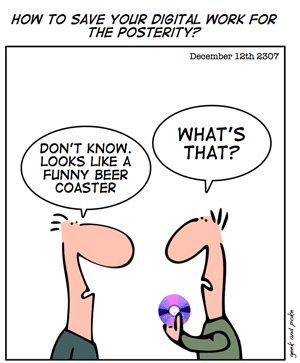 by Ingeborg Solvberg and Andreas Rauber
by Ingeborg Solvberg and Andreas Rauber
When digital representations of information objects first became available, they were seen as the solution to a myriad of problems relating to replication, distribution, ease of use and maintenance. Instead of filling up shelves and filing cabinets with documents, numeric data or fragile physical objects, the digital versions of these data promised to be space saving. They could also be copied and stored without loss or degradation - right up until the moment when the hardware and software environment required to interpret them became obsolete and they were suddenly lost (not degrading slowly, but in a very binary fashion, suddenly and completely lost).
Digital objects need specific viewer applications to be interpreted. These, in turn, need specific libraries installed on a specific operating system. The operating system runs on very specific hardware configurations for which drivers are provided. At the same time, digital objects are preserved on storage media, which themselves are fragile, as is the device technology needed to read them. All of these factors combine to ensure that digital objects are severely vulnerable to obsolescence: if any of the layers in the dependency tree is lost, the entire object ceases to be accessible and usable. On top of that, we find vulnerabilities regarding the interpretation of objects, documenting their provenance and limitations, ensuring that they are authentic and trustworthy.
Digital Preservation encompasses the activities that try to ensure that digital objects remain accessible and usable in an authentic way for long periods of time. Here, ‘long term’ can mean anything from a few years to decades and ultimately centuries: anything that is long enough to experience technological change that threatens the availability of a digital object.
In the last few years we have witnessed drastic changes in the field of digital preservation. First of all, the topic has moved from niche specialist discussions into broad mainstream awareness: public media are publishing and broadcasting detailed accounts of the challenges of keeping digital objects available for longer times than the increasingly short technology cycles allow. This has also led to a sudden recognition of the size of the stakeholder community, which includes not only data archives and heritage institutions (for a long time the sole drivers of this topic), but (e)-governments, industry, small and medium enterprises, and society at large, as our lives become increasingly shaped and based upon digital processes and artefacts.
The second drastic change we have witnessed recently is the fact that more solutions are becoming available and being deployed. This may be attributed to the provision of significant R&D funds for this massive challenge of keeping digital objects accessible and usable. Numerous research projects have been supported globally in recent years, with tools, guidelines and standards maturing to the point of production-level deployment. Still, the problem is far from being solved. While some areas are already quite well understood, for others we can only guess at the suitability of the solutions available; while for some we have solid tools available, for other areas we have only prototypes that hint at possible solutions or show the scale of the problem; while in some cases we have well-defined procedures in place, there are others where we have done little more than bought a few years of time in which to come up with better solutions.
This edition of ERCIM News brings together an exciting overview of the achievements and current activities in the field of Digital Preservation. It presents some of the most outstanding work in the field, ranging from issues of standardization and the development of models, via the creation of concrete solutions, tools and frameworks to deploy them, to case studies and reports of evaluating and discussing the state of research and development in a number of case studies and testbed settings. We believe that this selection of articles provides an excellent overview of and entry point to this challenging domain, serving both as a starting point to identify solutions to one’s own personal and institutional preservation needs as well as a good overview of the topics currently being addressed in research projects.
Please contact:
Andreas Rauber
TU Vienna, Austria, AARIT
E-mail:
Ingeborg Solvberg
NTNU, Norway
E-mail:










